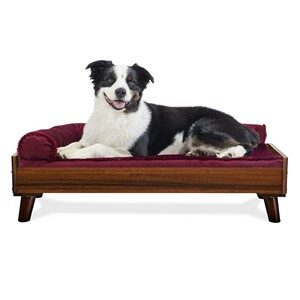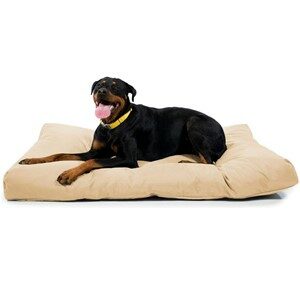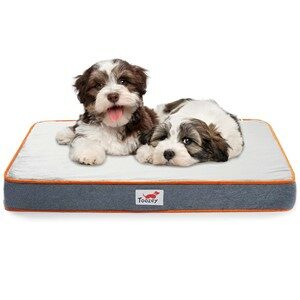Why My Dog Doesn’t Use His Bed
Learn Why Your Dog Does Not Use His Bed!
Introduction
Dog beds are a staple in many households that have a dog, providing our furry companion with a cozy and comfortable space to rest and relax. It is not uncommon to find dogs opting for other spots around the house instead of their designated bed. By reading further will help you understand why my dog doesn’t use his bed.
This curious behavior has puzzled dog owners for generations.
In this article, we’ll explore some of the reasons why dogs don’t always use their dog bed and what you can do to encourage them to enjoy their own special space.
The Bed Is Uncomfortable
Dogs may not use their dog bed if it is not comfortable or doesn’t provide the support they need. If the bed is too firm, too soft, or poorly constructed, they may prefer other resting spots in the house. If you notice your dog suddenly stop using their bed or exhibits reluctance to do so, it is essential to consider the possibility of an underlying medical issue.
Dogs are remarkably resilient and often hide signs of pain or discomfort. They may avoid their bed as it exacerbates any physical ailments. Orthopedic issues like joint pain, or skin problems can make the bed uncomfortable or unsuitable for them. An orthopedic dog bed may be the best solution to their problem.
Temperature Preferences
One of the primary reasons dogs may avoid their dog beds is temperature preference. Dogs are known for being creatures of comfort, and their fur regulates their body temperature. Depending on the weather or the room’s temperature, your dog might seek out cooler or warmer spots to rest in. In the summer months, the dog bed may feel too warm for them, and in the winter, they might prefer cuddling up on a cooler floor.
Since dogs are sensitive to temperature, and if their bed is too hot or too cold, they may choose to lie on cooler or warmer surfaces instead. If you notice this, you can move his bed in the location where he seeks the more comfortable temperature change.
The location placement of the bed matters here. If your dog bed is in a location that is too noisy, drafty, or lacks a sense of security, your dog may seek out a more suitable place.
If you live in a cold climate, you might want to consider buying a self-warming or heated bed to keep your dog warm.
Scent and Familiarity
Dogs have an extraordinary sense of smell, and they use it to navigate and understand their surroundings. This also includes their bed. New dog beds often have a distinct, unfamiliar scent that might deter your dog from using his bed immediately. The unfamiliar smell can make him feel uneasy or unsafe, prompting your dog to seek out other familiar spots that carry their scent or the scent of their dog owners.
Dogs rely on their sense of smell, and if the bed has been washed with strong detergents that does not retain their scent, they just might avoid using it.
Behavioral Conditioning Factors
A couple of factors might be in play here and the first one is if your dog was not properly trained to use his bed, he might not understand that it is their designated resting spot. He may have to be trained on how to use his bed.
A second factor is if your dog had previously associated their dog bed with negative experiences, they may avoid using it. For example, if the dog has been reprimanded while on their bed or it they were consistently forced to use it against their will, they might associate negative emotions with the bed. In these cases, it becomes crucial to recondition their behavior and make the dog bed a positive and inviting place to use.
Finally, dogs are pack animals, and they may prefer to be close to their human family members or other pets, which can lead them to choose spots where they feel more connected.
Submissive or Vulnerable Position
When dogs are sleeping it is a vulnerable activity for dogs. In the wild, they would choose safe and concealed spots to sleep. They would also avoid open and exposed areas that could make them vulnerable to potential threats.
A raised dog bed might not be the ideal choice for some dogs, as it places them in a more exposed and submissive position. Dogs might instead opt for low, secluded areas, like under furniture, for a better sense of security.
Medical Issues and Discomfort
If your dog is experiencing some pain or discomfort due to health issues, they may seek alternative places to rest. You may notice them moving closer to the source of warmth or a more supportive surface.
Preference for Owner’s Company
Dogs are social animals and thrive on human companionship. If you should notice your dog is particularly attached to you, they may choose to be wherever you are rather than using their own bed. Dogs might also associate their owner’s presence with comfort and safety, opting to stay close to them instead of using their bed in another room of the house.
Boredom or Lack of Stimulation
In case you may not know, dogs need mental and physical stimulation. If they are bored or not getting enough exercise, they may roam around the house instead of settling on their dog bed.
It is essential that dog owners see that their furry friend gets plenty of exercise every day which includes walks, and training sessions. This will ensure that your dog will be tired and will not roam around the house and will settle on his bed.
Encourage Your Dog to Use Their Bed
Understanding why dogs might avoid using their dog beds is the first step in addressing this issue. Below, we will share some tips to encourage your furry friend to use their bed:
- Introduce the Bed Gradually: Allow your dog to become familiar with their new bed by placing it in a common area first, rather than immediately confining it to a secluded spot. Make him smell the bed first before having him to lie on it.
- Make The Bed Cozy: Try this, add familiar scents, such as your dog’s favorite toy or a piece of your clothing, to make the bed more inviting and comforting. You may also use some of his favorite treats to get him acclimated with the bed.
- Use Positive Reinforcement: You can reward your dog with treats and praise when they use their bed or even sit on it for a short time. By using positive association will help them to view their bed as a pleasant place to rest and sleep.
- Choose The Right Bed: Before bringing any dog bed home for the first time, you need to consider your dog’s size, age, and health conditions when selecting a dog bed. Don’t forget to know his sleeping style so the bed matches it. If you should have an older dog, you might want to consider buying an orthopedic dog bed. These beds are ideal for your senior dog or any dog that is suffering with arthritis, muscle pain or joint issues.
- Location is important: Be sure to place his bed in a quiet, draft-free area where your dog can observe their surroundings comfortably. Also, be sure that the bed is placed in an area that is out of the way of heavy traffic areas from family members. It is important your dog has a place he can call his own with minimal interruption.
Conclusion
You must keep in mind that each dog is unique, and the reasons for them not using their dog bed will vary from one dog to another. Understanding your dog’s specific needs and preferences can help you provide him a suitable resting place.
While it may be perplexing that dogs don’t always use their dog beds, it’s essential to remember that their behavior is influenced by their instincts, preferences, and past experiences.
By understanding these factors and taking the steps to make their bed a more appealing option, you can provide your furry companion with a comfortable and secure resting space they will eventually learn to love and enjoy.
Patience, positive reinforcement, and a deep understanding of your dog’s physical needs will help create a harmonious bond between your canine companion and their bed.
Related Articles
Below are some articles that you might be interested in to learn more about dogs and their beds.
- Health Issues Dogs Can Have with Beds
- How Not To Choose A Dog Bed
- Is A Dog Bed Necessary
- Signs Your Dog Is Ill
- Using Alexa For Dog Behaviors
Go back to the Dog Luxury Beds home page.


